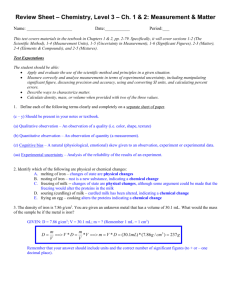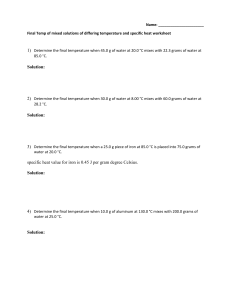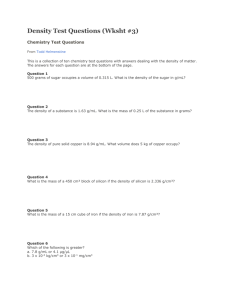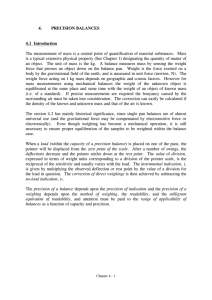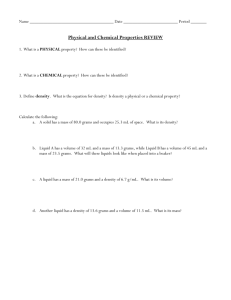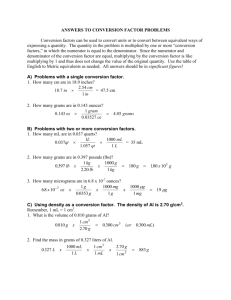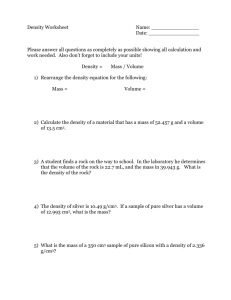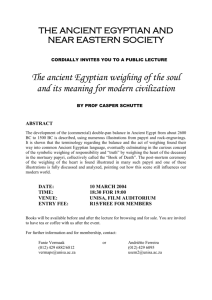Review Sheet – Chemistry – Ch
advertisement
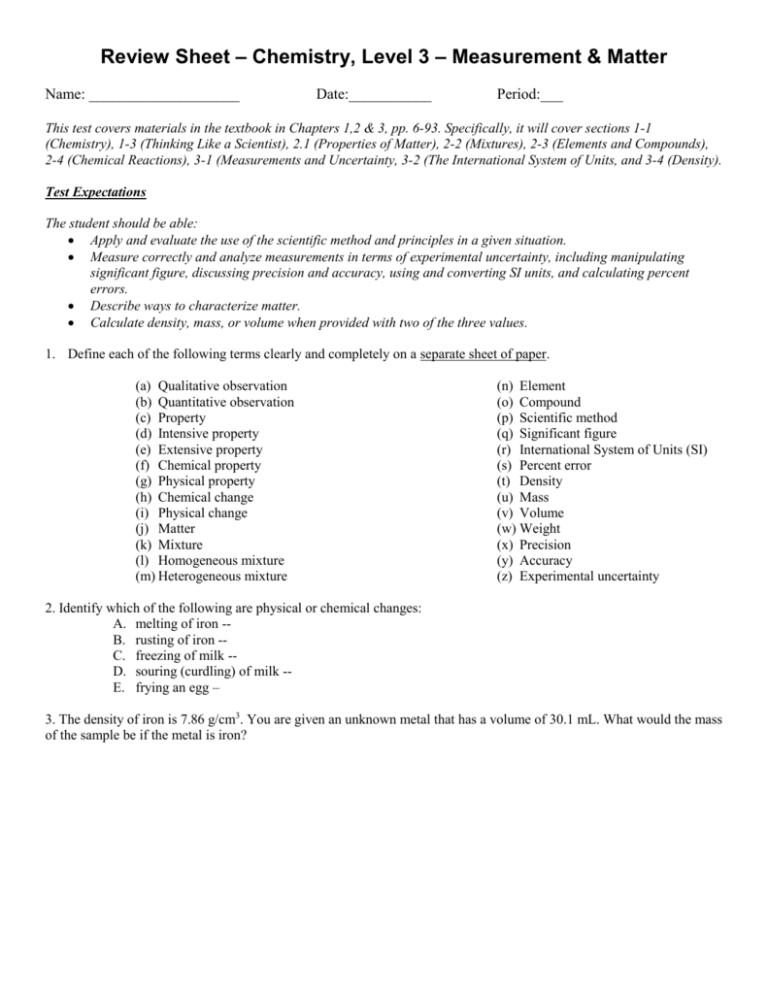
Review Sheet – Chemistry, Level 3 – Measurement & Matter Name: ____________________ Date:___________ Period:___ This test covers materials in the textbook in Chapters 1,2 & 3, pp. 6-93. Specifically, it will cover sections 1-1 (Chemistry), 1-3 (Thinking Like a Scientist), 2.1 (Properties of Matter), 2-2 (Mixtures), 2-3 (Elements and Compounds), 2-4 (Chemical Reactions), 3-1 (Measurements and Uncertainty, 3-2 (The International System of Units, and 3-4 (Density). Test Expectations The student should be able: Apply and evaluate the use of the scientific method and principles in a given situation. Measure correctly and analyze measurements in terms of experimental uncertainty, including manipulating significant figure, discussing precision and accuracy, using and converting SI units, and calculating percent errors. Describe ways to characterize matter. Calculate density, mass, or volume when provided with two of the three values. 1. Define each of the following terms clearly and completely on a separate sheet of paper. (a) Qualitative observation (b) Quantitative observation (c) Property (d) Intensive property (e) Extensive property (f) Chemical property (g) Physical property (h) Chemical change (i) Physical change (j) Matter (k) Mixture (l) Homogeneous mixture (m) Heterogeneous mixture (n) Element (o) Compound (p) Scientific method (q) Significant figure (r) International System of Units (SI) (s) Percent error (t) Density (u) Mass (v) Volume (w) Weight (x) Precision (y) Accuracy (z) Experimental uncertainty 2. Identify which of the following are physical or chemical changes: A. melting of iron -B. rusting of iron -C. freezing of milk -D. souring (curdling) of milk -E. frying an egg – 3. The density of iron is 7.86 g/cm3. You are given an unknown metal that has a volume of 30.1 mL. What would the mass of the sample be if the metal is iron? 4. A student performed an experiment to determine the density of gold, she collected the following measurements: mass of gold = 380.2 grams, volume of gold = 18.9 cm3. The “accepted” density of gold is 19.3 g/cm3 (8 points). A. What is the density that the student measured? B. What is the percent error in the student’s measurement? 5. Yoda is trying to measure the temperature of the water in the swamp by his house. He takes two samples, one of 1 L and one of 5 L’s. Will his temperature readings be the same for both samples? Explain. What kind of property is temperature (extensive or intensive)? 6. Perform the following calculations, then round off each answer to the proper number of significant figures. a. 6.15 m x 3.026 m x 0.018 m = _________________________ b. 124.5 g + 52.673 g + 20.0 g = _________________________ 7. Identify how many significant digits are in each of the following measurements and write your answer on the line. a. 187.032 g _____________ b. 130,040 ______________ c. 0.0601 m3 _____________ d. 620 L ________________ Round (a) and (b) to 2 significant figures. (a)________________ (b) ___________________ 8. Convert the following values into the requested units: (a) 20 km = __________ m (b) 1.6 km = ______ cm (c) 450 mL = _________ L (d) 9,506 g = _______ kg (e) 3150 s = _______ min. (f) 0.059 L = _______ mL (g) 1.15 kg = _______ g (h) 10.6 mg = __________ g (i) 145 nm = ________μm (i) 10.5 hL = __________ cL 9. A. Two students made multiple weighings of a copper cylinder, each using a different balance. The “correct” mass of the cylinder has been previously determined to be 47.432 grams. Describe the accuracy and precision of each student’s measurements. Weighing (grams) Weighing 1 Weighing 2 Weighing 3 Weighing 4 Igor 47.13 47.94 46.83 47.47 Katja 47.95 47.91 47.89 47.93 Igor: Katja: 10. Psychology researchers wonder if certain types of music will enhance the cognitive ability (intelligence) of rats. Eighteen laboratory rats are trained to run through mazes. The rats are separated into three groups of five. One group listens to a CD of nature sounds for an hour. Then, one at a time, they are placed in a new maze and timed as they run to the food at the end. A second group is played a CD of classical music (Beethoven) for an hour and then given the same task. A third group is played a CD of heavy metal music (Metallica!!!) for the same length of time and then run the mazes. The researchers find that the average time is 95 s. for the first group, 74 s. for the second group, and 128 s. for the third group. Which group is the control group? ______________________ What is the independent variable for this experiment? _________________________________________ What is the dependent variable in this experiment? ______________________________________ What might the hypothesis be for this experiment? How might you improve this experiment? 10. Calculate the area of this paper in square centimeters (cm2) using the measuring device provided. Measure and calculate as precisely as possible. (Area = length x width)
